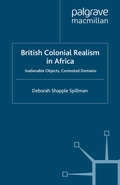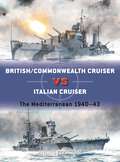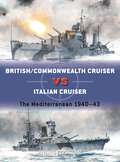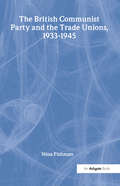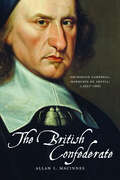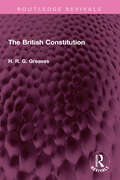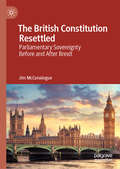- Table View
- List View
British Colonial Policy in the Twentieth Century (Routledge Revivals)
by Hugh , EgertonPublished in 1922, this book provides a history of the era as well as making reference to Britain’s colonial past. Egerton discusses British policies in her territories, as well as trials and tribulations that faced the British Empires influence at the dawn of the twentieth century.
British Colonial Policy in the Twentieth Century (Routledge Revivals)
by Hugh , EgertonPublished in 1922, this book provides a history of the era as well as making reference to Britain’s colonial past. Egerton discusses British policies in her territories, as well as trials and tribulations that faced the British Empires influence at the dawn of the twentieth century.
British Colonial Realism in Africa: Inalienable Objects, Contested Domains (Palgrave Studies in Nineteenth-Century Writing and Culture)
by Deborah Shapple SpillmanWhat role do objects play in realist narratives as they move between societies and their different systems of value as commodities, as charms, as gifts, as trophies, or as curses? This book explores how the struggle to represent objects in British colonial realism corresponded with historical struggles over the material world and its significance.
British Commando 1940–45 (Warrior)
by Angus Konstam Graham TurnerWith Hitler's army rampaging across Europe, Winston Churchill ordered the creation of a special fighting force – the Commandos. These valiant men were volunteers drawn from the ranks of the British Army, formed into a Special Service Brigade and put through a rigorous but highly effective training programme. Over the course of World War II they would see action in every major theatre of operation and are credited with numerous feats of gallantry during the D-Day landings. Although many units were disbanded after the war, the Royal Marine Commandos have maintained the standards of this elite fighting formation to the present day.Angus Konstam explores the history of the Commandos during their formative years, providing detailed descriptions of their training, weapons and equipment. Battle reports are accompanied by specially commissioned Osprey artwork and historical photographs, offering readers an in-depth analysis of some of the most famous fighting units in the British Army's history.
British Commando 1940–45 (Warrior)
by Angus Konstam Mr Graham TurnerWith Hitler's army rampaging across Europe, Winston Churchill ordered the creation of a special fighting force – the Commandos. These valiant men were volunteers drawn from the ranks of the British Army, formed into a Special Service Brigade and put through a rigorous but highly effective training programme. Over the course of World War II they would see action in every major theatre of operation and are credited with numerous feats of gallantry during the D-Day landings. Although many units were disbanded after the war, the Royal Marine Commandos have maintained the standards of this elite fighting formation to the present day.Angus Konstam explores the history of the Commandos during their formative years, providing detailed descriptions of their training, weapons and equipment. Battle reports are accompanied by specially commissioned Osprey artwork and historical photographs, offering readers an in-depth analysis of some of the most famous fighting units in the British Army's history.
The British Commonwealth and Victory in the Second World War (Studies in Military and Strategic History)
by Iain E. Johnston-WhiteThis book is the first comprehensive study of the British Commonwealth in the Second World War. Britain and its Dominions, Canada, Australia, New Zealand and South Africa, formed the most durable, cooperative and interchangeable alliance of the war. Iain E. Johnston-White looks in depth at how the Commonwealth war effort was financed, the training of airmen for the air war, the problems of seaborne supply and the battles fought in North Africa. Fully one third of the ‘British’ effort originated in the Dominions, a contribution that was only possible through the symbiotic relationship that Britain maintained with its former settler-colonies. This cooperation was based upon a mutual self-interest that was largely maintained throughout the war. In this book, Johnston-White offers a fundamental reorientation in our understanding of British grand strategy in the Second World War.
British/Commonwealth Cruiser vs Italian Cruiser: The Mediterranean 1940–43 (Duel)
by Angus KonstamThis illustrated history explores the cruiser forces of the Italian and British Royal navies, the jack-of-all trades warships of the Mediterranean Naval War.In 1940, when Italy entered World War II, the Royal Navy was badly overstretched, and its Mediterranean Fleet had to face both the Italian Navy and the German and Italian Air Forces in a battle for supremacy. Although the British and Italian battle fleets squared off against each other, they were both often held in reserve, in case the enemy fleet put to sea. So, it was left to the cruisers to wage their own naval war in the Mediterranean. This involved a range of missions, from escorting convoys and hunting enemy ones, to fighting for control of the sea around key locations such as the waters off Malta and Crete. This superbly illustrated study, written by renowned naval expert Angus Konstam, compares and contrasts the design, weapon technologies and combat performance of the opposing cruiser forces. It also documents several major clashes between British, Commonwealth and Italian cruisers, including spirited actions fought off Cape Spada in 1940, a string of actions in the Gulf of Sirte throughout 1941, battles against Axis convoys in 1941–42, and the Battle of Pantelleria in 1942. Among the subjects of the specially commissioned colour artworks are HMAS Sydney, HMS Naiad, RM Trento and RM Raimondo Montecuccoli.
British/Commonwealth Cruiser vs Italian Cruiser: The Mediterranean 1940–43 (Duel)
by Angus KonstamThis illustrated history explores the cruiser forces of the Italian and British Royal navies, the jack-of-all trades warships of the Mediterranean Naval War.In 1940, when Italy entered World War II, the Royal Navy was badly overstretched, and its Mediterranean Fleet had to face both the Italian Navy and the German and Italian Air Forces in a battle for supremacy. Although the British and Italian battle fleets squared off against each other, they were both often held in reserve, in case the enemy fleet put to sea. So, it was left to the cruisers to wage their own naval war in the Mediterranean. This involved a range of missions, from escorting convoys and hunting enemy ones, to fighting for control of the sea around key locations such as the waters off Malta and Crete. This superbly illustrated study, written by renowned naval expert Angus Konstam, compares and contrasts the design, weapon technologies and combat performance of the opposing cruiser forces. It also documents several major clashes between British, Commonwealth and Italian cruisers, including spirited actions fought off Cape Spada in 1940, a string of actions in the Gulf of Sirte throughout 1941, battles against Axis convoys in 1941–42, and the Battle of Pantelleria in 1942. Among the subjects of the specially commissioned colour artworks are HMAS Sydney, HMS Naiad, RM Trento and RM Raimondo Montecuccoli.
The British Communist Party and the Trade Unions, 1933–1945
by Nina FishmanThis is a pathbreaking book, essential reading for students of interwar political and social history. Previous histories of the period have underestimated the crucial role which Communists played in trade union organisation from top to bottom. Despite its relatively small size the Communist Party occupied a strategic place in the trade union movement: the leaders of the movement, notably Ernest Bevin, refused to acknowledge this at the time. Thanks to her extensive research and numerous interviews, and to the ’opening of the books’ of the Communist Part, Nina Fishman has been able to uncover a fascinating story, one which official Communist historians have never told, and which other historians could only recount in fragments. The main protagonists are the Communist Party General Seretary, Harry Pollitt, and the Editor of the Daily Worker, Johnny Campbell. The book brings to vivid life the work of activists on the shop floor and in the coalmines during the Depression and the Second World War. The book includes the first comprehensive analysis of Communist activity in key sectors of the British economy, notably in engineering shop stewards’ movements and among London busmen. It concludes with an authoritative review of Communists' part in the British war economy and a vigorous challenge to the conventional wisdom about the effect of Communist Party changes of line on the war on activists’ abilities to incite and lead strikes.
The British Communist Party and the Trade Unions, 1933–1945
by Nina FishmanThis is a pathbreaking book, essential reading for students of interwar political and social history. Previous histories of the period have underestimated the crucial role which Communists played in trade union organisation from top to bottom. Despite its relatively small size the Communist Party occupied a strategic place in the trade union movement: the leaders of the movement, notably Ernest Bevin, refused to acknowledge this at the time. Thanks to her extensive research and numerous interviews, and to the ’opening of the books’ of the Communist Part, Nina Fishman has been able to uncover a fascinating story, one which official Communist historians have never told, and which other historians could only recount in fragments. The main protagonists are the Communist Party General Seretary, Harry Pollitt, and the Editor of the Daily Worker, Johnny Campbell. The book brings to vivid life the work of activists on the shop floor and in the coalmines during the Depression and the Second World War. The book includes the first comprehensive analysis of Communist activity in key sectors of the British economy, notably in engineering shop stewards’ movements and among London busmen. It concludes with an authoritative review of Communists' part in the British war economy and a vigorous challenge to the conventional wisdom about the effect of Communist Party changes of line on the war on activists’ abilities to incite and lead strikes.
British Concepts of Heroic "Gallantry" and the Sixties Transition: The Politics of Medals (Routledge Studies in Cultural History #101)
by Matthew J. LordThis book examines the relationship between concepts of heroic "gallantry," as projected by the British honours system, and the sociocultural, political, military and international transitions of the supposed Sixties "cultural revolution." In so doing, it considers how a conservative, hierarchical and state-orientated concept both evolved and endured during a period of immense change in which traditional assumptions of deference to elites were increasingly challenged. Covering the period often defined as "The Long Sixties," from 1955–79, this study concentrates on four distinct transitions undergone by both state and non-state gallantry awards, including developments within the welfare state, class and gender discrimination, counterinsurgency and decolonisation. It ultimately sheds fresh light upon the importance of postwar decades to the continued evolution of concepts of gallantry and heroism in British culture using a range of underexplored government and media archives. It will be of interest to scholars, students and general researchers of heroism in modern Britain, the Sixties revolution, postwar military history and both the social and political evolution of British honours, decorations and medals.
British Concepts of Heroic "Gallantry" and the Sixties Transition: The Politics of Medals (Routledge Studies in Cultural History #101)
by Matthew J. LordThis book examines the relationship between concepts of heroic "gallantry," as projected by the British honours system, and the sociocultural, political, military and international transitions of the supposed Sixties "cultural revolution." In so doing, it considers how a conservative, hierarchical and state-orientated concept both evolved and endured during a period of immense change in which traditional assumptions of deference to elites were increasingly challenged. Covering the period often defined as "The Long Sixties," from 1955–79, this study concentrates on four distinct transitions undergone by both state and non-state gallantry awards, including developments within the welfare state, class and gender discrimination, counterinsurgency and decolonisation. It ultimately sheds fresh light upon the importance of postwar decades to the continued evolution of concepts of gallantry and heroism in British culture using a range of underexplored government and media archives. It will be of interest to scholars, students and general researchers of heroism in modern Britain, the Sixties revolution, postwar military history and both the social and political evolution of British honours, decorations and medals.
The British Confederate: Archibald Campbell, Marquess of Argyll, c.1607–1661
by Allan I. MacInnesThe interplay of roles of the Marquess of Argyll, as clan chief, Scottish magnate and influential British statesman, make him a worthy counterpoint to Cromwell. This book reviews Argyll’s formative influence in shaping British frontier policy during the period 1607–38 and his radical, financially creative and highly partial leadership of the Covenanting Movement in Scotland, 1638–45, when Covenanters rather than Royalists or Parliamentarians directed the political agenda in Britain. It examines his role as reluctant but calculated revolutionary in pursuing confessional confederation throughout the British Isles, and in restoring Scotland’s international relations particularly with France. His ambivalent role as a military leader is contrasted with that of his genius as a political operator, 1646–51. Reappraising his trial and execution as a scapegoat for reputedly collaborating with Oliver Cromwell and the regicides who executed Charles I in the 1650s, it rehabilitates Argyll’s reputation as a tarnished Covenanting hero rather than an unalloyed Royalist villain. The book is firmly grounded in public and private archival sources in the UK, the USA and Scandinavia, and draws especially on privileged access to archives in Inveraray Castle, Argyllshire. It should appeal to those interested in clanship, civil war and British state formation.
British Conservatism and Trade Unionism, 1945–1964
by Peter DoreyFor most of the twentieth century, the Conservative Party engaged in an ongoing struggle to curb the power of the trade unions, culminating in the radical legislation of the Thatcher governments. Yet, as this book shows, for a brief period between the end of the Second World War and the election of Harold Wilson's Labour government in 1964, the Conservative Party adopted a remarkably constructive and conciliatory approach to the trade unions, dubbed 'voluntarism'. During this time the party leadership made strenuous efforts to avoid, as far as was politically possible, confrontation with, or legislation against, the trade unions, even when this incurred the wrath of some Conservative backbenchers and the Party's mass membership. In explaining why the Conservative leadership sought to avoid conflict with the trade unions, this study considers the economic circumstances of the period in question, the political environment, electoral considerations, the perspective adopted by the Conservative leadership in comprehending industrial relations and explaining conflict in the workplace, and the personalities of both the Conservative leadership and the key figures in the trade unions. Making extensive use of primary and archival sources it explains why the 1945-64 period was unique in the Conservative Party's approach to Britain's trade unions. By 1964, though, even hitherto Conservative defenders of voluntarism were acknowledging that some form of official inquiry into the conduct and operation of trade British unionism, as a prelude to legislation, was necessary, thereby signifying that the heyday of 'voluntarism' and cordial relations between senior Conservatives and the trade unions was coming to an end.
British Conservatism and Trade Unionism, 1945–1964
by Peter DoreyFor most of the twentieth century, the Conservative Party engaged in an ongoing struggle to curb the power of the trade unions, culminating in the radical legislation of the Thatcher governments. Yet, as this book shows, for a brief period between the end of the Second World War and the election of Harold Wilson's Labour government in 1964, the Conservative Party adopted a remarkably constructive and conciliatory approach to the trade unions, dubbed 'voluntarism'. During this time the party leadership made strenuous efforts to avoid, as far as was politically possible, confrontation with, or legislation against, the trade unions, even when this incurred the wrath of some Conservative backbenchers and the Party's mass membership. In explaining why the Conservative leadership sought to avoid conflict with the trade unions, this study considers the economic circumstances of the period in question, the political environment, electoral considerations, the perspective adopted by the Conservative leadership in comprehending industrial relations and explaining conflict in the workplace, and the personalities of both the Conservative leadership and the key figures in the trade unions. Making extensive use of primary and archival sources it explains why the 1945-64 period was unique in the Conservative Party's approach to Britain's trade unions. By 1964, though, even hitherto Conservative defenders of voluntarism were acknowledging that some form of official inquiry into the conduct and operation of trade British unionism, as a prelude to legislation, was necessary, thereby signifying that the heyday of 'voluntarism' and cordial relations between senior Conservatives and the trade unions was coming to an end.
The British Conservative Party: Ideology and Citizenship (Routledge Studies in Modern British History)
by Lenon Campos MaschetteCitizenship has been an ill-explored subject within Conservative Party studies. When this subject has been analysed, it is usually made by scholars of citizenship, more concerned with general overviews than understanding specific Conservative approaches to the concept. This book intends to fill this gap. Through a rigorous analysis of sources, the author explores how the Conservative Party contested the welfare model of citizenship and sought to recreate a new relationship between the individual, the state and civil society. Starting from Thatcher’s idea of ‘active citizenship’ and going through the analysis of John Major’s ‘Citizen’s Charter’ and David Cameron’s ‘Big Society’ project, the book sheds new light on how these developments responded to long-term problems while dialoguing with specific circumstances and the different Conservative leaders’ ideas. From an ideological perspective, the author analyses how these leaders echoed and re-signified more traditional political ideas and ideologies while negotiating with and borrowing new flourishing concepts during those years. Far from being a unidimensional citizenship concept, in reinterpreting old ideas and utilizing new ones, these Conservatives elaborated a complex and many times contradictory citizenship model that tried to address both long-lasting and more timely issues that overlapped in British society.
The British Conservative Party: Ideology and Citizenship (Routledge Studies in Modern British History)
by Lenon Campos MaschetteCitizenship has been an ill-explored subject within Conservative Party studies. When this subject has been analysed, it is usually made by scholars of citizenship, more concerned with general overviews than understanding specific Conservative approaches to the concept. This book intends to fill this gap. Through a rigorous analysis of sources, the author explores how the Conservative Party contested the welfare model of citizenship and sought to recreate a new relationship between the individual, the state and civil society. Starting from Thatcher’s idea of ‘active citizenship’ and going through the analysis of John Major’s ‘Citizen’s Charter’ and David Cameron’s ‘Big Society’ project, the book sheds new light on how these developments responded to long-term problems while dialoguing with specific circumstances and the different Conservative leaders’ ideas. From an ideological perspective, the author analyses how these leaders echoed and re-signified more traditional political ideas and ideologies while negotiating with and borrowing new flourishing concepts during those years. Far from being a unidimensional citizenship concept, in reinterpreting old ideas and utilizing new ones, these Conservatives elaborated a complex and many times contradictory citizenship model that tried to address both long-lasting and more timely issues that overlapped in British society.
The British Constitution (Routledge Revivals)
by H.R.G. GreavesFirst published in 1938, The British Constitution discusses the basic features of the British Constitution. The author argues that the Constitution is more than a body of institutions working in accordance with principles laid down in law or expressed in conventions. It is society in its political aspect. In addition to the features of the Constitution, the book also explains the functions of the House of Commons, the House of Lords, the King, the Cabinet, the parties, the administration and the armed forces. This book will be of interest to anyone keen on learning about the British Constitution as well as students of political science and history.
The British Constitution (Routledge Revivals)
by H.R.G. GreavesFirst published in 1938, The British Constitution discusses the basic features of the British Constitution. The author argues that the Constitution is more than a body of institutions working in accordance with principles laid down in law or expressed in conventions. It is society in its political aspect. In addition to the features of the Constitution, the book also explains the functions of the House of Commons, the House of Lords, the King, the Cabinet, the parties, the administration and the armed forces. This book will be of interest to anyone keen on learning about the British Constitution as well as students of political science and history.
The British Constitution Resettled: Parliamentary Sovereignty Before and After Brexit
by Jim McConalogueAdopting a political constitutionalist view of the British constitution, this book critically explores the history of legal and political thought on parliamentary sovereignty in the UK. It argues that EU membership strongly unsettled the historical precedents underpinning UK parliamentary sovereignty. Successive governments adopted practices which, although preserving fundamental legal rules, were at odds with past precedents. The author uses three key EU case studies – the financial transactions tax, freedom of movement of persons, and the working time directive – to illustrate that since 1973 the UK incorporated EU institutions which unsettled those precedents. The book further shows that the parliament’s place since the referendum on Brexit in June 2016 and the scrutinising of the terms of the withdrawal agreement constitute an enhanced, new constitutional resettlement, and a realignment of parliament with the historical precedent of consent and its sovereignty.
The British Consular Service in the Aegean and the Collection of Antiquities for the British Museum
by Lucia Patrizio GunningThe book tells the story of how the British consular service in the Aegean, in the years of the British protectorate of the Ionian Islands (1815-1864) became an agency for the retrieval, excavation and collection of antiquities eventually destined for the British Museum. Exploring the historical, political and diplomatic circumstances that allowed the consular service to develop from a chartered company into a state run institution under the direction of the Foreign Office, it provides a unique perspective on the intersection of state policy, private ambition, and the collecting of antiquities. Drawing extensively on consular correspondence, the study sets out several challenges to current views. For those interested in the history of travel in the Levant, or more generally in the Grand Tour, the book presents an alternative point of view that challenges the travellers' descriptions of the region. The book also intersects with British diplomatic history, providing an insight into the consuls in both their official and private circumstances, and comparing their situation under the Levant Company with that of the Foreign Office run consular service. The complex political situation in the Aegean at the time of the take over of the service is examined along with the political and commercial roles of the consuls, their daily dealings with the Greeks and Ionians, and also with the Ottoman authorities. Through private correspondence, it shows how the consuls' reflected the belief that Greek, Egyptian, Babylonian, Roman and other antiquities would be better looked after in a British, French, German or American museum, than by the people, and in the countries, they were created for. In particular, the book illuminates the public/private nature of the consuls' role, the way they worked with, but independently of, government, and it reveals how Britain was able to acquire major pieces of sculpture from the nineteenth century Aegean.
The British Consular Service in the Aegean and the Collection of Antiquities for the British Museum
by Lucia Patrizio GunningThe book tells the story of how the British consular service in the Aegean, in the years of the British protectorate of the Ionian Islands (1815-1864) became an agency for the retrieval, excavation and collection of antiquities eventually destined for the British Museum. Exploring the historical, political and diplomatic circumstances that allowed the consular service to develop from a chartered company into a state run institution under the direction of the Foreign Office, it provides a unique perspective on the intersection of state policy, private ambition, and the collecting of antiquities. Drawing extensively on consular correspondence, the study sets out several challenges to current views. For those interested in the history of travel in the Levant, or more generally in the Grand Tour, the book presents an alternative point of view that challenges the travellers' descriptions of the region. The book also intersects with British diplomatic history, providing an insight into the consuls in both their official and private circumstances, and comparing their situation under the Levant Company with that of the Foreign Office run consular service. The complex political situation in the Aegean at the time of the take over of the service is examined along with the political and commercial roles of the consuls, their daily dealings with the Greeks and Ionians, and also with the Ottoman authorities. Through private correspondence, it shows how the consuls' reflected the belief that Greek, Egyptian, Babylonian, Roman and other antiquities would be better looked after in a British, French, German or American museum, than by the people, and in the countries, they were created for. In particular, the book illuminates the public/private nature of the consuls' role, the way they worked with, but independently of, government, and it reveals how Britain was able to acquire major pieces of sculpture from the nineteenth century Aegean.
British Contested History: Place and Space
by Caroline DonnellanThis book examines the issues arising from British contested history by looking at how it came to be constructed, how it developed, and how attitudes over time have begun to change towards it. It considers how this narrative was first created through the writing of British history. It explores the private spaces of the court, the political places of the state, and the public places of the street. Beyond British shores this history has also been enacted through international heritage sites when objects were removed and taken back to Britain. Conclusively, it explores how the historic spaces of a maritime city, has further entrenched an already complex history of the nation. How this research brings new insights into this field is by looking at it through the lens of place, space, and the spatial turn. The underlining research questions are: What role does place and space play in historical constructions of the past? How do place and space contribute to contested history? How can these places and spaces be re-appropriated and reused, and endowed with new meanings?
The British Cotton Trade, 1660-1815 Vol 1
by Beverly LemireFirst published in 2010. Cotton was the first industrialized global trade. This four-volume reset edition charts the rise of British trade in cotton from the days of small-scale trading between the Middle East and India to the domination of British-led industrialized manufacture. Part contains ‘Early Years of Trade and British Response to Indian Cottons to the late 1600s’.
The British Cotton Trade, 1660-1815 Vol 1
by Beverly LemireFirst published in 2010. Cotton was the first industrialized global trade. This four-volume reset edition charts the rise of British trade in cotton from the days of small-scale trading between the Middle East and India to the domination of British-led industrialized manufacture. Part contains ‘Early Years of Trade and British Response to Indian Cottons to the late 1600s’.

